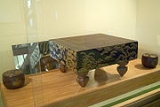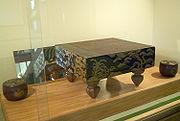
Four go houses
Encyclopedia
In the history of go
in Japan
, the Four go houses were the four academies of Go
instituted, supported, and controlled by the state, at the beginning of the Tokugawa shogunate
. At roughly the same time shogi
was organised into three houses. Here 'house' implies institution run on the recognised lines of the iemoto
system common in all Japanese traditional arts. In particular the house head had, in three of the four cases, a name handed down: Inoue Inseki, Yasui Senkaku, Hayashi Monnyu. References to these names therefore mean to the contemporary head of house.
The four academies were the Honinbo go house, Hayashi go house
, Inoue go house and Yasui house. Theoretically these were on a par, and competed in the official castle games called oshirogo
.
 The first of the four houses was the house Honinbo, founded by Honinbo Sansa. Honinbo Sansa was a buddhist monk, and had been appointed Godokoro (minister of go) by Tokugawa Ieyasu after the unification of Japan in 1603.
The first of the four houses was the house Honinbo, founded by Honinbo Sansa. Honinbo Sansa was a buddhist monk, and had been appointed Godokoro (minister of go) by Tokugawa Ieyasu after the unification of Japan in 1603.
. All players were therefore male. Some outward forms only persisted of that connection, with the oshirogo games being played in Buddhist dress and with shaven heads; the stylish Ota Yuzo was given a waiver of the obligation since he was proud of his hair.After Honinbo Doetsu
made a representation that long sleeves were troublesome for the players, a dispensation for shorter sleeves was allowed to them. At least in theory, matters on succession in the houses was subject to the authority of the jisha bugyo, an official regulating religious establishments. Nominations as heir, typically within the iemoto system of the best disciple, who might not be a natural son but in effect adopted, were supposed to be made official. Deaths at an early age particularly affected the Honinbo house, and irregular succession could occur with potential for scandal.
and godokoro
were awarded, somewhat sporadically, and brought great prestige to the house. In practice backstairs intrigue was often brought to bear on the appointments. More creditably, since the Meijin title could only be awarded to the undisputed master player of the time, there were occasions when it was withheld from two candidates whose merit was very close (an example was Genjo and Chitoku, around 1810-1820).
, brought a consistent and high level of play (though some say the standard sagged in the eighteenth century). Esoteric teaching was normal, with collections of very difficult tsumego
being compiled, one of which, the Igo Hatsuryon, is still used for professional training. Prepared variations were used in top games (notably in the blood-vomiting game
of Jowa and Akaboshi). Go secrets were state secrets, in effect; since the country was closed to foreigners, in the main, the only international competition was against players from the Ryukyu Islands
, but those games are still cited as examples of the difference between strong amateurs and really strong players.
threw the system into disarray, but three houses survived some hard times to 1900. Honinbo Shusai
arranged that the Honinbo title should become a tournament of the Nihon Kiin after his death (1939). The Yasui house died out; it is not certain whether the Inoue house theoretically continues or not, though it dropped out of the mainstream from the 1920s.
Go (board game)
Go , is an ancient board game for two players that originated in China more than 2,000 years ago...
in Japan
Japan
Japan is an island nation in East Asia. Located in the Pacific Ocean, it lies to the east of the Sea of Japan, China, North Korea, South Korea and Russia, stretching from the Sea of Okhotsk in the north to the East China Sea and Taiwan in the south...
, the Four go houses were the four academies of Go
Go (board game)
Go , is an ancient board game for two players that originated in China more than 2,000 years ago...
instituted, supported, and controlled by the state, at the beginning of the Tokugawa shogunate
Tokugawa shogunate
The Tokugawa shogunate, also known as the and the , was a feudal regime of Japan established by Tokugawa Ieyasu and ruled by the shoguns of the Tokugawa family. This period is known as the Edo period and gets its name from the capital city, Edo, which is now called Tokyo, after the name was...
. At roughly the same time shogi
Shogi
, also known as Japanese chess, is a two-player board game in the same family as Western chess, chaturanga, and Chinese Xiangqi, and is the most popular of a family of chess variants native to Japan...
was organised into three houses. Here 'house' implies institution run on the recognised lines of the iemoto
Iemoto
Iemoto is a Japanese term used to refer to the founder or current head master of a certain school of traditional Japanese art...
system common in all Japanese traditional arts. In particular the house head had, in three of the four cases, a name handed down: Inoue Inseki, Yasui Senkaku, Hayashi Monnyu. References to these names therefore mean to the contemporary head of house.
The four academies were the Honinbo go house, Hayashi go house
Hayashi house
The Hayashi house was one of the four go houses of Edo period Japan. It was in effect the junior partner in the system of go schools, never providing a Meijin player. Always an ally of the Honinbo school, for traditional reasons, it didn't survive to the end of the period as truly independent...
, Inoue go house and Yasui house. Theoretically these were on a par, and competed in the official castle games called oshirogo
Oshirogo
A castle game , in relation to high-level go played in Japan during the Edo period, was an official match played by representatives of the four go houses in the castle of the shogun...
.
History

Buddhist connections
They were also nominally Buddhist institutions, with the Honinbo and Hayashi aligned with the Nichiren sect, and the Inoue and Yasui with the Jodo ShuJodo Shu
, also known as Jōdo Buddhism, is a branch of Pure Land Buddhism derived from the teachings of the Japanese ex-Tendai monk Hōnen. It was established in 1175 and is the most widely practiced branch of Buddhism in Japan, along with Jōdo Shinshū....
. All players were therefore male. Some outward forms only persisted of that connection, with the oshirogo games being played in Buddhist dress and with shaven heads; the stylish Ota Yuzo was given a waiver of the obligation since he was proud of his hair.After Honinbo Doetsu
Honinbo Doetsu
Hon'inbō Dōetsu was a Japanese professional go player, who became the third head of the Honinbo house. His surname was Niwa, and he used a Buddhist name Nissho.-Biography:...
made a representation that long sleeves were troublesome for the players, a dispensation for shorter sleeves was allowed to them. At least in theory, matters on succession in the houses was subject to the authority of the jisha bugyo, an official regulating religious establishments. Nominations as heir, typically within the iemoto system of the best disciple, who might not be a natural son but in effect adopted, were supposed to be made official. Deaths at an early age particularly affected the Honinbo house, and irregular succession could occur with potential for scandal.
Official status
The official posts of MeijinMeijin
Meijin , literally translated, means "Brilliant Man." It is the name of the second most prestigious Japanese Go Tournament. It also refers to a traditional Japanese title given to the strongest player of the day during the Edo period.- The tournament :...
and godokoro
Godokoro
is a title that was given in Japan from the beginning of the Edo period until the Meiji Restoration. In that period it was the highest official standing that could be attained by a go player. Literally it is a metonym, meaning the 'go office'....
were awarded, somewhat sporadically, and brought great prestige to the house. In practice backstairs intrigue was often brought to bear on the appointments. More creditably, since the Meijin title could only be awarded to the undisputed master player of the time, there were occasions when it was withheld from two candidates whose merit was very close (an example was Genjo and Chitoku, around 1810-1820).
Teaching
The mode of teaching, by apprenticeshipApprenticeship
Apprenticeship is a system of training a new generation of practitioners of a skill. Apprentices or protégés build their careers from apprenticeships...
, brought a consistent and high level of play (though some say the standard sagged in the eighteenth century). Esoteric teaching was normal, with collections of very difficult tsumego
Tsumego
is the Japanese term for a Go problem based on life-and-death. The term likely comes from , as means mating in Shogi but has no meaning in Go. Tsumego problems are common in newspaper columns; the usual format is of a position set up on some delimited area of the board, and the instruction reads...
being compiled, one of which, the Igo Hatsuryon, is still used for professional training. Prepared variations were used in top games (notably in the blood-vomiting game
Blood-vomiting game
The blood-vomiting game is a famous game of go of the Edo period of Japan, played on June 27, 1835 between Honinbo Jowa and Intetsu Akaboshi...
of Jowa and Akaboshi). Go secrets were state secrets, in effect; since the country was closed to foreigners, in the main, the only international competition was against players from the Ryukyu Islands
Ryukyu Islands
The , also known as the , is a chain of islands in the western Pacific, on the eastern limit of the East China Sea and to the southwest of the island of Kyushu in Japan. From about 1829 until the mid 20th century, they were alternately called Luchu, Loochoo, or Lewchew, akin to the Mandarin...
, but those games are still cited as examples of the difference between strong amateurs and really strong players.
Later history
After a while the Honinbo house (of Dosaku) emerged as most prestigious, and the Hayashi house ran into difficulties, eventually being taken over by the Honinbo. The Meiji RestorationMeiji Restoration
The , also known as the Meiji Ishin, Revolution, Reform or Renewal, was a chain of events that restored imperial rule to Japan in 1868...
threw the system into disarray, but three houses survived some hard times to 1900. Honinbo Shusai
Honinbo Shusai
is the professional name of Hoju Tamura, also known as , who was a Japanese professional Go player.- Biography :He was born in Shiba, Tokyo, son of Tamura Yasunaga, a retainer of the shogun. He learned go at age 10 and joined the Hoensha in 1883, then under the leadership of Murase Shuho. He was...
arranged that the Honinbo title should become a tournament of the Nihon Kiin after his death (1939). The Yasui house died out; it is not certain whether the Inoue house theoretically continues or not, though it dropped out of the mainstream from the 1920s.

